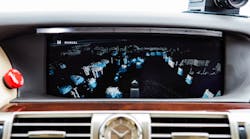Whenever the first fully autonomous cars start driving passengers, every vehicle will probably be equipped with three primary sensors to monitor road conditions, each one covering each other’s blind spots. Radar systems have low resolution but operate in bad weather conditions fumbled by cameras and lidar sensors, which themselves compensate for radar’s resolution issues.
On Semiconductor is already a major manufacturer of image sensors. But in recent years, the Phoenix, Arizona-based company has been acquiring automotive radar and other sensors to build more complete solutions around its core business. It is also trying to take advantage of the shift toward sensor fusion, which involves combining raw data generated by different sensors into more insightful information, enhancing automotive safety or other applications.
The company recently made another move in that direction with the acquisition of Cork, Ireland-based SensL Technologies, which specializes in single photon avalanche diodes (SPAD) and silicon photomultipliers (SiPM) that can be used in lidar sensors that maps objects in three dimensions by bouncing laser beams off its surroundings. The terms of the deal were not disclosed.
SiPM chips are designed to sense the physical shape of objects and how far away they are. On Semiconductor is betting that they could be used as the building blocks of solid-state lidar solutions because they can be manufactured with complementary metal-oxide semiconductor (CMOS) technology. That would allow the devices to be much more robust, smaller and cheaper than currently available lidar sensors, because they will not have moving parts.
Taner Ozcelik, senior vice president of On Semiconductor’s image sensor group, said in a statement that “automotive sensor fusion demand is growing at an accelerated pace with a need for additional sensor technologies that are provided by the SensL team.” The company’s sensors can also be designed into industrial robotics, inspection drones and consumer devices, he said.
On Semiconductor is making moves on other fronts, too. Last year, it agreed to acquire an IBM research group focused on millimeter wave automotive radar. The acquisition included 15 researchers based in Haifa, Israel, working on increasing the output power for fixed-beam silicon chips operating in frequencies between 60 and 90 gigahertz. Before the end of the year, On Semiconductor plans to introduce samples of the chips.
Radar are widely used in cars because they function in all weather conditions, watching for other vehicles on the road when cameras are obscured by rain or thrown off by the sunlight reflecting off a snowy street. But they lack the resolution to distinguish objects, which is why lidar sensors are considered vital for autonomous driving. On the other hand, lidar sensors cannot see things like lane markings or the color in taillights—a shortcoming that cameras can compensate for.
On Semiconductor is facing off against numerous competitors that have raised hundreds of millions in venture capital to build better lidar. One stumbling block could be the significant expertise—ranging from optics that spray lasers out into the world and the software that processes the reflections—required to manufacture lidar for cars. To get around that, On Semiconductor could always sell the sensors to other companies with those supporting skills.
On Semiconductor’s lidar bet remains to be tested. Not yet clear is how much money the company plans to invest in its new SensL business, which will operate as part of On Semiconductor’s image sensor group. Last year, the company spent $594.5 million on research and development on annual revenue of $5.54 billion. SiPM sensors also have more traditional uses in medical imaging and radiation detection, Ozcelik said.

